You are viewing the Cultures of Knowledge Blog archive for the ‘Project Updates’ Category:
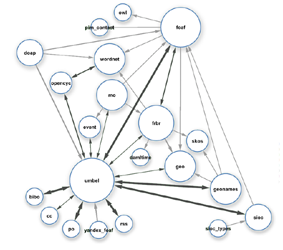 Following on from our participation in a Wikimedia-sponsored data workshop back in April, our technical director Neil Jefferies has published an excellent opinion piece on Representing Knowledge: Metadata, Data, and Linked Data in the latest issue of The Signpost, the community-edited newspaper covering Wikipedia and the Wikimedia Foundation. Neil draws on his extensive experience of knowledge management in both the commercial and academic library sectors to make a convincing case for flexible and non-prescriptive data models. Go read it!
Following on from our participation in a Wikimedia-sponsored data workshop back in April, our technical director Neil Jefferies has published an excellent opinion piece on Representing Knowledge: Metadata, Data, and Linked Data in the latest issue of The Signpost, the community-edited newspaper covering Wikipedia and the Wikimedia Foundation. Neil draws on his extensive experience of knowledge management in both the commercial and academic library sectors to make a convincing case for flexible and non-prescriptive data models. Go read it!
Kim McLean-Fiander
July 02, 2012
Events, Lectures, Podcasts, Project Updates, Publications
Tags: Cryptography, Editions, Elizabeth Stuart, Gender, Military History, Politics, Women
 Podcast available on the seminar page!
Podcast available on the seminar page!
Elizabeth Stuart, Queen of Bohemia (1596-1662) has often been portrayed as a romantic and frivolous figure; as a desperate, poverty-stricken, devout widow, or as a dilettante who spent her time going to ballets and masques and keeping the company of monkeys (which she allegedly enjoyed more than that of her children). A key constituent of these narratives has been the assumption that her political influence within Europe was negligible.
However, as Nadine Akkerman of Leiden University argued in her paper in our seminar series on 24 May (Opening up the Winter Queen’s Cabinet: The Correspondence of Elizabeth Stuart, Queen of Bohemia), this is a distorted and partial perception of the monarch that has largely arisen because historians have tended to overlook her vast correspondence. The fact is that Elizabeth’s nearly 1700 surviving letters from forty-seven archives in Europe and the US (estimated to be a mere 10% of what once existed) − which Nadine is editing for OUP − contain almost no information on her cultural life, and very little mention of plays, artists, or poets. They reveal instead that she was immersed in politics and was a keen follower of military affairs. Indeed, the underlying purpose of nearly all of her letters, Nadine argued, was to regain the lost Palatinate lands for her heirs.

Elizabeth, Queen of Bohemia
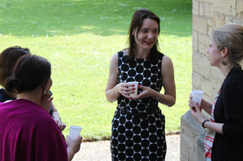
Nadine fields questions over drinks.
In a stimulating and wide-ranging analysis, Nadine discussed the often ignored, though politically important, roles of royal secretaries, scribes, and letter carriers. She traced the various ways by which Elizabeth attempted to outwit her brother Charles I’s surveillance of her correspondence (by using cryptography and steganography, for example), and suggested that Elizabeth used letters as a polite instrument by which to sabotage her brother’s plans for the Thirty Years War, thus making that event last ten years longer than it might otherwise have done. In sum, Nadine posited that an examination of this important though neglected correspondence should bring about an overdue reconfiguration of the Queen of Bohemia’s pivotal role in seventeenth-century diplomatic, military, and political history.
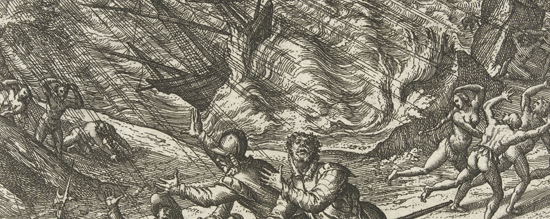
Here in the British Isles, summer is living up to its reputation: that is to say, we’re armed with umbrellas, and battling wind, rain, and flood on a daily basis. Indeed, a seasonal dip into EMLO reveals that heavy rainfall from May to September was not such an unusual occurrence.
Seventeenth- and eighteenth-century summers saw floods the length of the Cherwell valley. There were thunderstorms, whirlwinds and panic-stricken haymakers, damaged crops, stormy summer nights, as well as danger and disruption to transport. There were stiff August winds in the Solent and delays with naval manoeuvres on account of storms in the Channel. The summer of 1682 seems to have been especially wet. Magistrate Edmund Warcup laments the effects of rain on his corn and grass, of floods on his fields and livestock – the poor chap lives in fear of cattle rot – and is forced to take action against the deluge. On 9 May of this same year, clergyman William Jenkyn wrote to Philip Wharton to warn him that ‘the floods are out so bad between Uxbridge & London that it is very dangerous to travel so advises his Lordship to postpone his journey’.
Thus, although all was not gloom and doom during these seasonal soaks (James Long informs John Aubrey that lamprey eels are ‘plentiful in flood time’), it’s small wonder that the time-honoured cliché of sodden summers came into being. As we forego sandals and shorts for galoshes and gumboots, it’s worth reflecting that our ancestors may have been thankful for cold, wet summers as, with the heat in cities, came plague (more on that in a future post), and fine weather was not a cure for all ills. On 6 June 1677 Robert Digby wrote to Thomas Smith that he hoped to see him at the next sitting of Parliament ‘if I can get rid of my cough which wears away, God be thanked, very much this kind weather’, yet favourable temperatures did not work magic in this case; the poor young man was dead by the end of the year.
Miranda is editing metadata from the Bodleian card catalogue of correspondence for our union catalogue, Early Modern Letters Online. On a regular basis, she brings us hand-picked and contextualised records.
James Brown
June 12, 2012
Events, Lectures, Podcasts, Project Updates, Websites and Databases
Tags: Digitization, Editions, Electronic Enlightenment, France, Mapping the Republic of Letters, Networks, Text Mining, Visualization
 Podcast available on the seminar page!
Podcast available on the seminar page!
In the fourth paper of our seminar series on Thursday 17 May, Dr Glenn Roe – formerly of the University of Chicago, and current Mellon Fellow in Digital Humanities at Oxford’s OERC – gave a sophisticated and suggestive paper on ‘Text-Mining Electronic Enlightenment: Influence and Intertextuality in the Eighteenth-Century Republic of Letters’.
.
Building on his recent work with the Electronic Enlightenment corpus and other online repositories of long-form historical text, Glenn started his talk by observing the irony that the recent efflorescence of big data, culturomics, network analysis, and other quantitative approaches to culture – focusing in many cases on the macro interpretation of metadata over content – has authorized and promoted a convention of ‘not reading’ within the digital humanities, in which historical texts themselves can be marginalized or effaced altogether by the superabundance of information. The ready modelling of letters as a finite number of abstract datapoints (sender, recipient, and so on) and the vast quantities of diverse and often disorganized information exchanged within epistolary systems makes correspondence highly susceptible to such an approach.

Glenn during discussion.
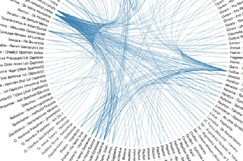
Visualizing influence.
As a supplement to this ‘distant’ reading, Glenn went on to demonstrate the potential of the latest machine-learning technologies to render significant volumes of transcription meaningful via text mining and the automated creation of patterns, frequencies, statistical models, and other forms of ‘mediated’ or ‘directed’ reading. Glenn distinguished between three kinds of text mining: predictive classification (used to generate new categories from unprocessed texts); comparative classification (used to correct and refine existing categories within processed texts); and similarity (used to measure broader similarities between documents and parts of documents, especially in terms of the identification of meaningful borrowing and instances of intertextuality). He then demonstrated each kind of approach within a rich series of examples drawn from his work with the ARTFL Encyclopédie Project, and most recently Electronic Enlightenment, before concluding his analysis by presenting – with caveats – some preliminary radial visualizations of textual influence generated using the D3 JavaScript library.
 With its whirl of bunting, teapots, cotton frocks, and the river pageant, Diamond Jubilee fever is sweeping the country for just the second time in British history. Early modern subjects might not have had the opportunity to celebrate a sixty-year reign, but it’s clear from Early Modern Letters Online – itself replete with royalty from across Europe – that they knew how to mark in style royal and aristocratic betrothals, marriages, and birthdays, whilst countrywide celebrations of military victories and triumphant peace treaties helped bolster national unity.
With its whirl of bunting, teapots, cotton frocks, and the river pageant, Diamond Jubilee fever is sweeping the country for just the second time in British history. Early modern subjects might not have had the opportunity to celebrate a sixty-year reign, but it’s clear from Early Modern Letters Online – itself replete with royalty from across Europe – that they knew how to mark in style royal and aristocratic betrothals, marriages, and birthdays, whilst countrywide celebrations of military victories and triumphant peace treaties helped bolster national unity.
Then, as now, cities, towns, and institutions arranged peals of bells, official gun salutes, and lavishly styled river pageants for their inhabitants to enjoy. Eminent speakers delivered orations and sermons from pulpits at moments of national importance – we read how ‘Dr. Sherlock is to preach in St. Pauls before Q.Anne to celebrate the glorys and triumphs of the late victorys in Germany. “You may easily imagine that the D. of M. will have no inconsiderable part in the panegyrie”’. Professional intelligencer John Pory wrote to Sir Robert Cotton in 1607 describing the masque Hymenaei which was designed by Inigo Jones and written by Ben Jonson to celebrate the marriage of Robert Devereux, Earl of Essex, and Lady Francis Howard (not that of Prince Henry, as erroneously noted in the abstract). Just as we do today, they enjoyed firework spectaculars; and at the end of the War of the Spanish Succession we find ‘an invitation to the freeholders of Canterbury to partake of a roast ox, bread and beer to celebrate Peace on July 8’ (a service in St Paul’s Cathedral was held also to mark the Peace of Utrecht, at which Handel’s Utrecht Te Deum and Jubilate was given its premiere). As one might expect, bonfires and beacons lit the night sky on numerous occasions and finery was donned for balls and dances, but, in a week during which the highlight here at Cultures of Knowledge has been a paper on the correspondence of James I’s daughter Elizabeth Stuart (podcast to come!), the ‘Winter Queen’ reminds us what’s missing today: scheduled into the festivities that marked her marriage to Frederick, Elector Palatine is the description of a ritual we have lost in these modern celebrations – the tilting match, or joust. Something to suggest to cyclists at the local street party?
Miranda is editing metadata from the Bodleian card catalogue of correspondence for our union catalogue, Early Modern Letters Online. On a regular basis, she brings us hand-picked and contextualised records.
Philip Beeley
May 31, 2012
Events, Lectures, Project Updates
Tags: Astronomy, Editions, Europe, History of Science, Johannes Hevelius, Networks, Seventeenth Century, Theft
On 26 September 1679, while the astronomer Johannes Hevelius and his wife Elizabetha were spending a relaxing evening in gardens outside the gates of their home city of Danzig (Gdańsk), fire consumed their house in the old town. A large part of their possessions, books, personal manuscripts, and instruments, was destroyed; by the following morning the observatory which Hevelius had carefully erected on the roof of the house lay in ruins.
Much was irretrievably lost, but remarkably the letters he had exchanged with the learned men and women of Europe, including Kepler, Boulliau, Gassendi, Christiaan Huygens, Oldenburg, Wallis, and Kircher, together with his treasured collection of Kepler manuscripts, survived. At that time comprising thirteen volumes, the correspondence of Hevelius constitutes one of the great resources for the study and appreciation of early modern scientific networks.

Hevelius’s 45m focal-length telescope.

Johannes Hevelius.
Making this extraordinarily rich corpus available to the wider scholarly community is the task of a major collaborative editorial project currently underway in France, Germany, and Poland, of which I am pleased to be serving on the advisory committee. With most of the over 2,700 surviving letters now housed in collections at the BNF and the Bibliothèque de l’Observatoire in Paris, it was particularly fitting that the director of the French team Professor Chantal Grell (University of Versailles) – accompanied by Professor Robert Halleux (University of Liège) – should inform our third seminar series of the background and methodologies of this ambitious enterprise on Thursday 10 May. In a talk entitled ‘Editing the Correspondence of Johannes Hevelius: Networks, Themes, and Methodological Challenges’, Chantal first provided an overview of Hevelius’s life and letters, before giving a lively account of the complex archival afterlives of the astronomer’s epistolary collection following his death in 1687, including details of the letters famously purloined by Guillaume Libri in the mid-nineteenth century. Following a conspectus of Hevelius’s many correspondents, Chantal concluded with an analysis of the exemplary seventeenth-century scientific exchange between Hevelius and Pierre de Noyers, the secretary to the Queen of Poland. Following an interesting question and answer session – which included, inter alia, discussion of the benefits and challenges of balancing hard copy and digital outputs within large-scale correspondence projects – the evening came to fitting conclusion with a visit to the opening of the Renaissance in Astronomy exhibition at the Museum of the History of Science.
Seminars take place in the Faculty of History on George Street on Thursdays at 3pm. For future talks in the series, please see the seminar webpage. All are welcome!
 Following on from our participation in a Wikimedia-sponsored data workshop back in April, our technical director Neil Jefferies has published an excellent opinion piece on Representing Knowledge: Metadata, Data, and Linked Data in the latest issue of The Signpost, the community-edited newspaper covering Wikipedia and the Wikimedia Foundation. Neil draws on his extensive experience of knowledge management in both the commercial and academic library sectors to make a convincing case for flexible and non-prescriptive data models. Go read it!
Following on from our participation in a Wikimedia-sponsored data workshop back in April, our technical director Neil Jefferies has published an excellent opinion piece on Representing Knowledge: Metadata, Data, and Linked Data in the latest issue of The Signpost, the community-edited newspaper covering Wikipedia and the Wikimedia Foundation. Neil draws on his extensive experience of knowledge management in both the commercial and academic library sectors to make a convincing case for flexible and non-prescriptive data models. Go read it!


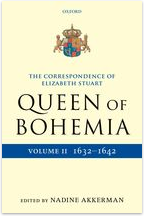




 With its whirl of bunting, teapots, cotton frocks, and the river pageant, Diamond Jubilee fever is sweeping the country for just the second time in British history. Early modern subjects might not have had the opportunity to celebrate a sixty-year reign, but it’s clear from
With its whirl of bunting, teapots, cotton frocks, and the river pageant, Diamond Jubilee fever is sweeping the country for just the second time in British history. Early modern subjects might not have had the opportunity to celebrate a sixty-year reign, but it’s clear from 


 Join
Join 